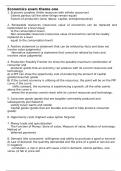Economics exam theme one
1. Economic problem (finite resources with infinite resources)
Ceteris paribus (all the other things remain equal)
Factors of production (land, labour, capital, entrepreneurship)
2. Renewable resources (resources value of economics can be replaced and
replenished on a level equal
to the consumption level)
Non-renewable resources (resources value of economics cannot be readily
replaced on a level
equal to the consumption level)
3. Positive statement (a statement that can be refuted by facts and does not
involve value judgments)
Normative statement (a statement that cannot be refuted by facts and
involves value judgments)
4. Production Possibly Frontier (to show the possible maximum combination of
consumer and
producer goods that an economy can produce with its current resources and
technology)
A) A PPF can show the opportunity cost of producing the amount of capital
goods/consumer goods
B) If the current economy is utilising all the resources, the point will be on the PPF
curve, if the curve
shifts outward, the economy is experiencing a growth, all the other points
above the curve is
where the economy cannot reach with its current resources and technology.
5. Consumer goods (goods that are tangible commodity produced and
subsequently purchased to
satisfy buyer wants and needs)
Capital goods (goods that are durable and used to help produce consumer
goods)
6. Opportunity costs (highest value option forgone)
7. Money trade and specialisation
The Function of Money: Store of value, Measure of value, Medium of exchange,
Method of
deferred payments
8. Demand (the consumers’ willingness and ability to purchase a good or service)
A) Law of demand: the quantity demanded and the price of a good or service are
in negative
correlation, a rise in price will cause a fall in demand, ceteris paribus, vice
versa. (A fall in price will
, cause an extension in demand, a rise in price will cause a contraction in
demand)
B) Consumers aim to maximise their utility.
C) Diminishing marginal of utility states that the satisfaction derived from the
consumption of an
additional unit of good will decrease as more of the good is consumed. The
increase in consumption
level derives the satisfaction level at a decreasing rate. The price that a
consumer is willing to pay
for a good or service derives from the utility that they gain from consuming the
good.
D) Factors that cause a shift in demand: price of substitutes + complementary
goods, income, trends,
expectation of consumers
E) Substitutes are goods that have similar features and function, one can be
replaced by
another. Substitutes effect is where two goods are substitutes and one is
cheaper, the cheaper one
will be more attractive to consumers, the demand for the more expensive one
will fall due to the
fall in sales.
F) Income effect is where there is a change in disposable income leading to a
change in consumer
purchasing power, if income rises, consumers are more able to purchase more
units of goods,
therefore, demand for certain goods will rise.
G) Veblen Goods have a paradox of value and an upward sloping demand curve,
when the price of a
scare good rises, the demand for good will rise
H) Marginal propensity to consume shows how much more individuals will spend
for every additional
unit of income
9. Supply (the producers’ willingness and ability to produce a good or service)
A) Law of supply: the quantity supplied and the price of a good or service are in
positive correlation, a
rise in price will cause a rise in supply, ceteris paribus, vice, versa. (A rise in
price will cause an
extension in supply, and a fall in price will cause a contraction in supply)
B) Producers/suppliers aim to maximise profits
C) Factors that cause a shift in supply: costs of productions, productivity,
efficiency, government
intervention, prices of other goods
10. Price determination
A) Market equilibrium is where the quantity supplied is equal to the quantity
demanded




